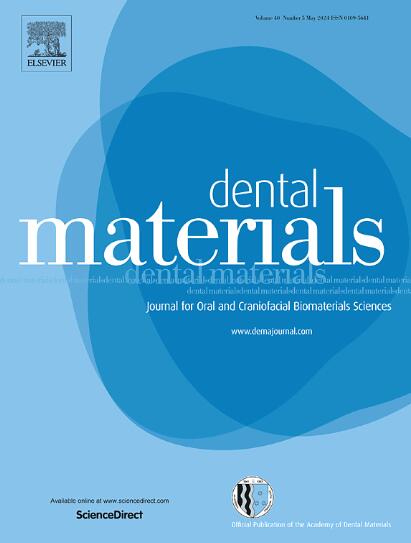Changes in the composition and mechanical properties of dentin in mouse models of diabetes
IF 4.6
1区 医学
Q1 DENTISTRY, ORAL SURGERY & MEDICINE
引用次数: 0
Abstract
Objectives
This study employed mouse models of type 1 (T1D) and type 2 (T2D) diabetes to characterize the changes in tooth dentin composition and its mechanical properties.
Methods
Thirty-two mice were used in this study and divided into T1D, T2D and corresponding control groups. Mandibles were extracted 12 weeks after the onset of diabetes, and dentin from the first molars was evaluated in varying regions of the root. The composition was assessed using Raman Spectroscopy. Nanoindentation and Vickers indentation were employed to study the mechanical properties of the tissue. Statistical significance was evaluated by two-way analysis of variance with respect to the diabetic group and region of the tooth (p ≤ 0.05).
Results
In the T2D model, the mineral-to-collagen ratio, hardness, and storage modulus of the intertubular dentin were significantly reduced compared to tissue from the controls, especially in the cervical regions of the tooth. The reduction in the mineral-to-collagen ratio was also observed in the T1D model, but changes in nanomechanical properties were not evident. However, the bulk hardness of the teeth in the T1D model was lower than in the littermate controls. Optical microscopy revealed significant wear of the tooth crowns in both models of diabetes, which appear to result from parafunctional activities.
Conclusion
This study suggests that both type 1 and type 2 models of diabetes are associated with detrimental changes in dentin.
Clinical significance
Better understanding of how diabetes affects dentin and the contributing mechanisms will be key to improving treatments for people with diabetes.
糖尿病小鼠模型牙本质成分和机械性能的变化。
目的:本研究采用 1 型糖尿病(T1D)和 2 型糖尿病(T2D)小鼠模型,研究牙本质成分及其机械性能的变化:本研究采用 1 型糖尿病(T1D)和 2 型糖尿病(T2D)小鼠模型来描述牙齿牙本质成分及其机械性能的变化:本研究使用 32 只小鼠,分为 1 型糖尿病组、2 型糖尿病组和相应的对照组。糖尿病发生 12 周后拔出下颌骨,评估第一磨牙根部不同区域的牙本质。使用拉曼光谱评估了牙本质的成分。纳米压痕法和维氏压痕法用于研究组织的机械性能。通过对糖尿病组和牙齿区域进行双向方差分析来评估统计学意义(P ≤ 0.05):结果:在 T2D 模型中,与对照组相比,管间牙本质的矿物质与胶原蛋白比率、硬度和储存模量显著降低,尤其是在牙颈部。在 T1D 模型中也观察到了矿物质与胶原蛋白比率的降低,但纳米力学性能的变化并不明显。不过,T1D 模型牙齿的硬度低于同种对照组。光学显微镜检查发现,两种糖尿病模型的牙冠都有明显磨损,这似乎是副功能活动造成的:这项研究表明,1 型和 2 型糖尿病模型都与牙本质的有害变化有关:临床意义:更好地了解糖尿病对牙本质的影响及其机制将是改善糖尿病患者治疗的关键。
本文章由计算机程序翻译,如有差异,请以英文原文为准。
求助全文
约1分钟内获得全文
求助全文
来源期刊

Dental Materials
工程技术-材料科学:生物材料
CiteScore
9.80
自引率
10.00%
发文量
290
审稿时长
67 days
期刊介绍:
Dental Materials publishes original research, review articles, and short communications.
Academy of Dental Materials members click here to register for free access to Dental Materials online.
The principal aim of Dental Materials is to promote rapid communication of scientific information between academia, industry, and the dental practitioner. Original Manuscripts on clinical and laboratory research of basic and applied character which focus on the properties or performance of dental materials or the reaction of host tissues to materials are given priority publication. Other acceptable topics include application technology in clinical dentistry and dental laboratory technology.
Comprehensive reviews and editorial commentaries on pertinent subjects will be considered.
 求助内容:
求助内容: 应助结果提醒方式:
应助结果提醒方式:


